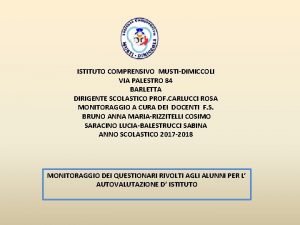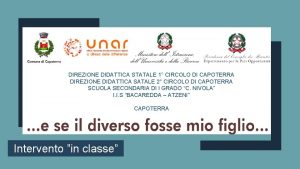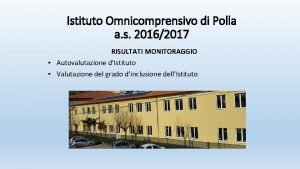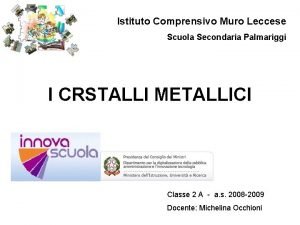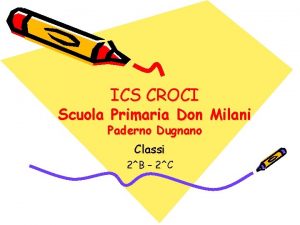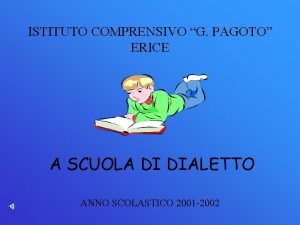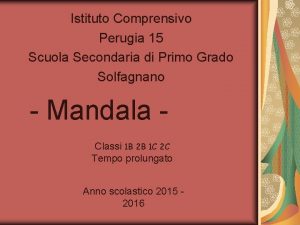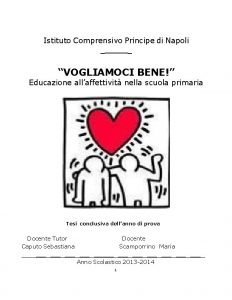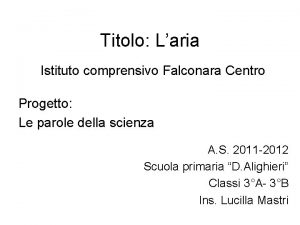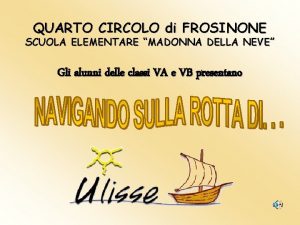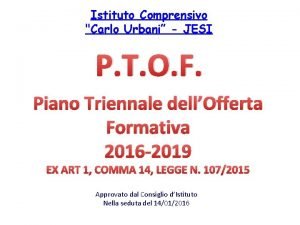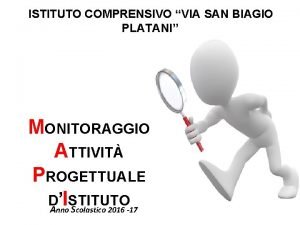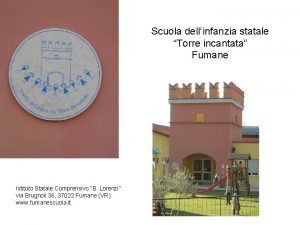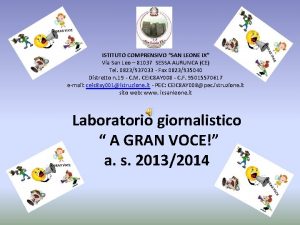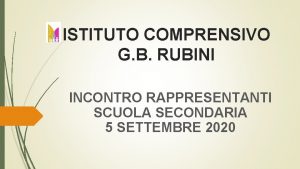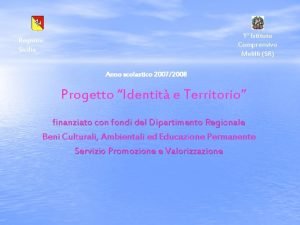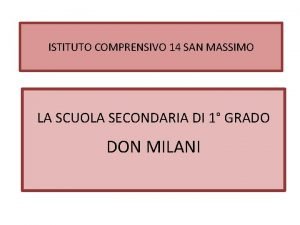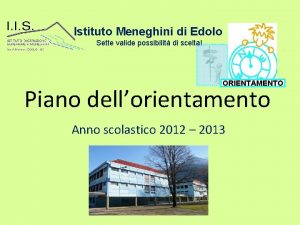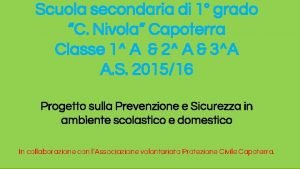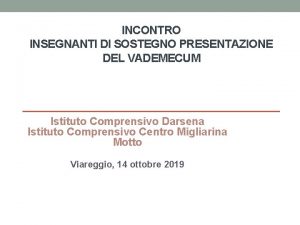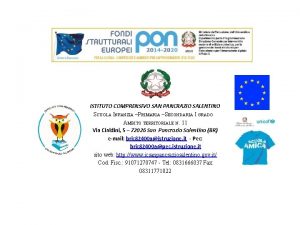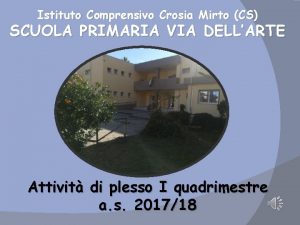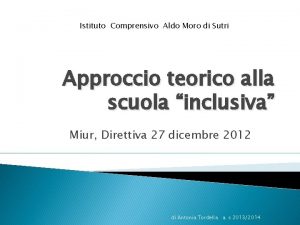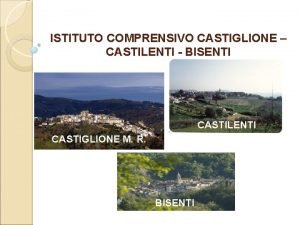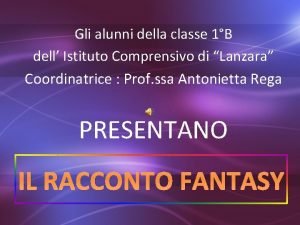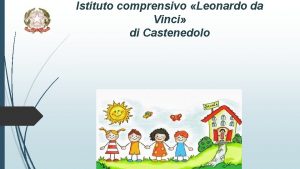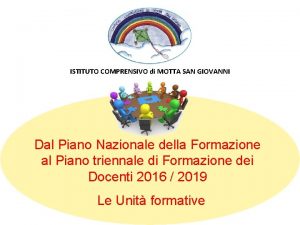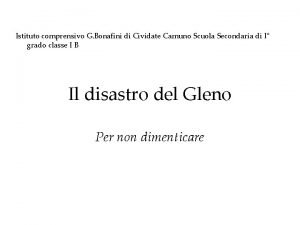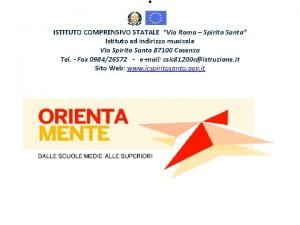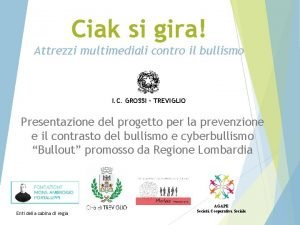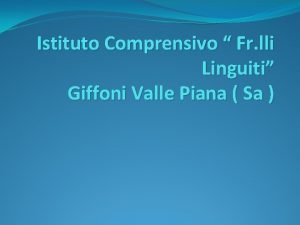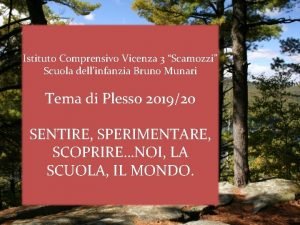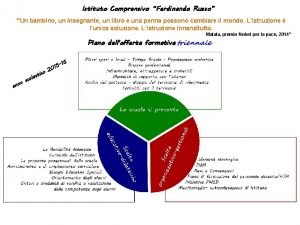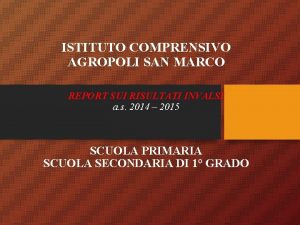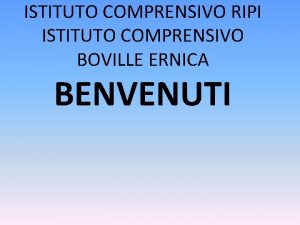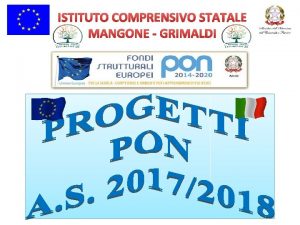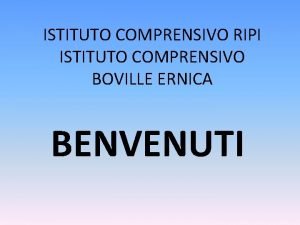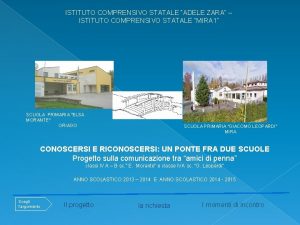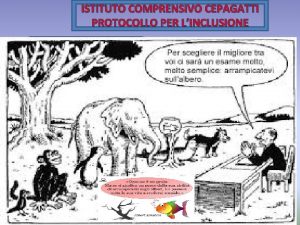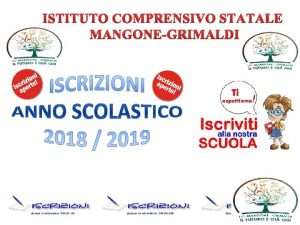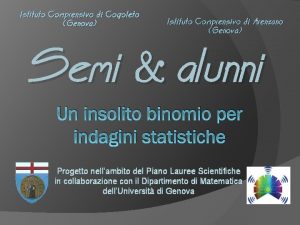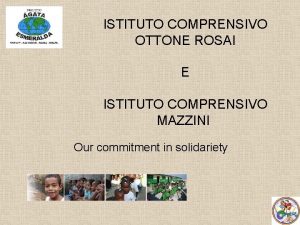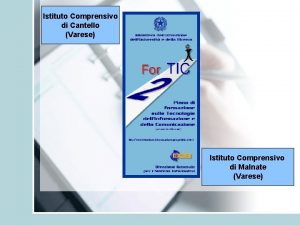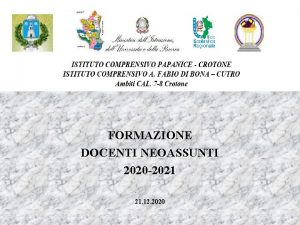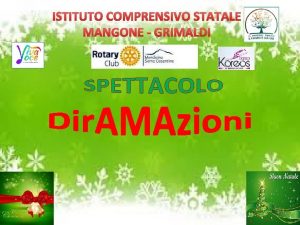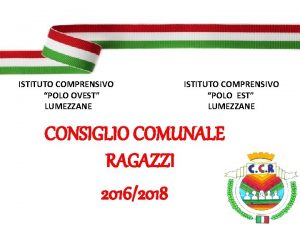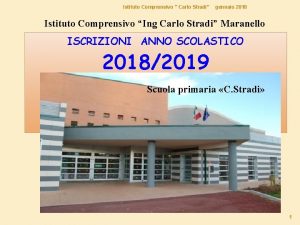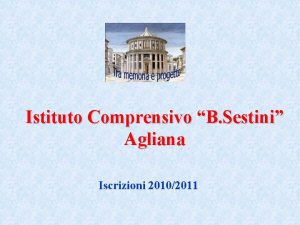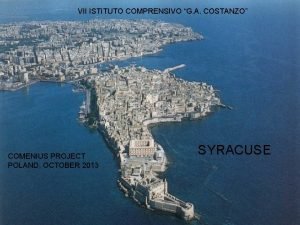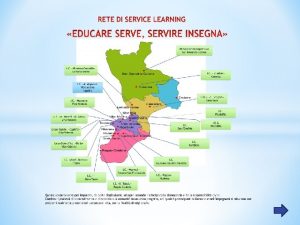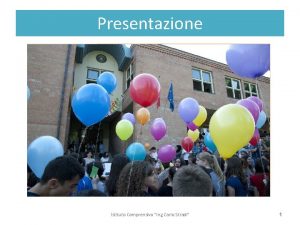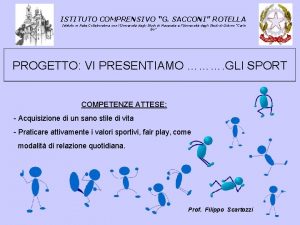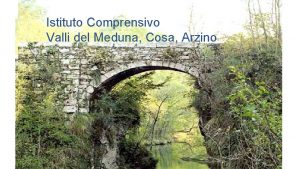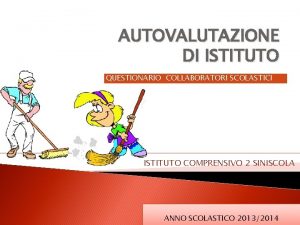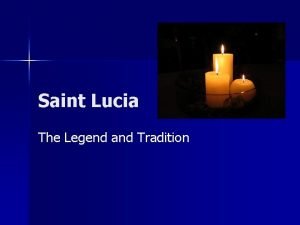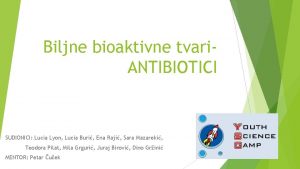Istituto Comprensivo S Lucia di Chiaromonte a s









































- Slides: 41

Istituto Comprensivo “S. Lucia” di Chiaromonte a. s 2009/2010 1. MOTIVARE GLI STUDENTI E I DOCENTI DANDO VALORE AGGIUNTIVO ALL’ESPERIENZA QUOTIDIANA 2. COMUNICARE E COLLABORARE COME AMANO I GIOVANI 3. IMPARARE DAL CONFRONTO E DALLO SCAMBIO 4. CONDIVIDERE ESPERIENZE CON I COLLEGHI BUONI MOTIVI PER SVILUPPARE UN PROGETTO E-TWINNING 5. REALIZZARE PERCORSI CREATIVI E INNOVATIVI ATTRAVERSO TUTTE LE DISCIPLINE 6. USARE LE TECNOLOGIE DELL’INFORMAZIONE E DELLA COMUNICAZIONE PER ACCORCIARE LE DISTANZE E CONSENTIRE AD INSEGNANTI E STUDENTI DI RAGGIUNGERE REALTA’ DIFFERENTI 7. MOTIVARE GLI STUDENTI CON ATTIVITA’ INNOVATIVE, NUOVE ED INTERESSANTI 8. IMPARARE COSE NUOVE SUI DIVERSI SISTEMI SCOLASTICI NELLE ALTRE NAZIONI EUROPEE 9. CONDIVIDERE E SCAMBIARE OPINIONI IN AMBITO PEDAGOGICO CON ALTRI INSEGNANTI EUROPEI ARRICCHENDO COSI’ LA PROPRIA ESPERIENZA 10. MIGLIORARE LA CONOSCENZA DELLE LINGUE STRANIERE A cura di Paola Ponzo 11. MIGLIORARE I METODI DI INSEGNAMENTO METTENDOLI A CONFRONTO E ADOTTANDO UN DIVERSO APPROCCIO

Questo progetto ci ha aiutati a: 1. 2. 3. 4. 5. 6. 7. 8. 9. 10. 11. 12. 13. Sviluppare l’amore per le bellezze e le tradizioni locali creando un calendario Stimolare l’interesse per la conoscenza di un altro paese Donare ai nostri alunni l’opportunità di conoscere realtà differenti Offrire a noi insegnanti un’occasione di confronto didattico a livello europeo per migliorare la propria professione Creare all’interno della scuola dei momenti concreti per lo sviluppo del lavoro di gruppo Rinforzare l’idea di identità europea Utilizzare i metodi didattici moderni Utilizzare le tecnologie di informazione e di comunicazione Stabilire una comunicazione tra culture diverse Insegnare la diversità, conoscerla e accettarla Ampliare la propria visione del mondo Scoprire le proprie tradizioni Potenziare l’uso della Lingua Inglese

CLASSI COINVOLTE: I, III A DELLA SCUOLA SECONDARIA DI I GRADO DI CARBONE a. s. 2009/2010 I A III A

PROCEDURA DI LAVORO… PRESENTAZIONI CARBONE


About me • I’m 12 years old. • I’m in II A (7° grade) • I live at Carbone, Italy.

My hobbies • • Playing tennis Playing basketball Playing football Playing Volleyball

MOVIES My favourite … • Spiderwick • Natale in Crociera (Italian Comedy) • Barzellette (Italian fiction) • FOOD • Pizza, pasta ( tortellini, Carbonara) MUSIC • Rap, Pop, Disco Dance

My aims… I hope I’ll be a lawyer

PRESENTAZIONI DORUK

Hello Italy! My name is Gizem Asmalı

This is me! • • I live in Manisa. I’m 12 years old. I’m in 6 st grade. I’ve got one brother.

HOBBİES • • Playing volleyball. Playing guitar. Reading book. Listening the music.

My favourite movies • Twilight • New moon • Harry potter

NATIONAL FESTIVALS

Carnival in Italy The word carnival, said carnovale in Tuscany, comes from the Latin carnem levare, an expression used in the middle ages which marked the beginning of the Lenten fast.

Origins of Carnival • A time of the year during which one was not allowed to eat meat (carne in Latin). But like many other festivals of our calendar, it derives from an ancient roman cult the Saturnalia, a pagan rites of fertility which were celebrated in honour of the god Saturn. During those celebrations everything was allowed, even disguising and change of rules. Carnivals were modified substantially because of its magic and ritual nature with Christianity, but it still was tolerated by the clergy. During the 15 th and 16 th century some traditions were recaptured and the use of masks and public fancies spread all over the country. (Arlecchino is one of the most famous Italian masks)

Italian Masks (Commedia dell’arte) The most famous Italian mask used during Carnival period come from the “Commedia dell'arte” "comedy of craft"). It is a professional form of theatre that began in Italy in the mid-16 th century, and was characterized by masked "types, " the advent of the actress, and improvised performances based on sketches or scenarios. It continued its popularity in France during the 17 th century, and evolved into various configurations across Europe. For example, Pantomime which flourished in the 18 th century owes its genesis to the character types of the commedia, particularly Arlecchino, Pulcinella, Brighella, Colombina.

Others are…… Pantalone, Gianduja, Meneghino, Stenterello, Tartaglia, Corallina, or Peppe Nappa

Masks and carnival parades • Parades with allegoric chariots took place every year in a lot of Italian cities. By the way, in the whole Italian territory, you may find parades of allegory chariots with masks, plays and exhibitions of typical masks and dresses. The most important parades take place in:

Venice • Carnevale in Venice is very different. Ten days of street jugglers, fire-eaters, acrobats and mime artists, and with fantastic masks and costumes. It all begins with the Children’s Carnival in Piazza San Marco, and climaxes on Shrove Tuesday, at midnight, as a masked Pantalon is burned. Half a million visitors each year enjoy this colourful and rather surreal celebration. Turn a corner at any time of day and you are likely to be confronted by Venetians in masks and costumes, with the city taking on a distinctly unreal air

Viareggio • The most famous Carnevale parade of them all, in Viareggio, is the culmination of months of work. Preparing the floats becomes a full-time job, and the parades are on the four Sundays before Shrove Tuesday. The floats (which satirise political and world figures) are beautifully constructed, and are complemented by food fairs and local feasts, puppet shows, an art exhibition, a flower show, and music and dancing.

• The Carnival of Acireale “ The most beautiful carnival in Sicily. . . a Baroque triumph of lights and colors” Acireale is undisputed "queen" of the Sicilian carnival. Ten artisan yards feverishly work every year to prepare as many wagons that, on the occasion of the "more beautiful carnival of Sicily", they unthread stately in procession for the roads of the center, in an exult of colors and imagination among thousand of people that fill the roads and the plazas of the city originating from the whole island.

Putignano The Putignano Carnival is the longest and oldest carnival in Europe. It is the longest because it starts on December 26 th with the "Rito della Proppagine" , and it is the oldest because it has now been established that on 26 th December, 1394 the mortal remains of St. Steven Protomartyr were transferred from Monopoli to Putignano. The emblem of the Putignano carnival is the mask of Farinella. The name derives from "farinella" ("a povele" in vernacular ) an ancient, but extremely tasty, poor man's dish consisting of ground chick peas and toasted barley mixed with sauces or eaten with fresh figs. Today Farinella resembles a court jester with his multicoloured costume and bells decorating the points of his hat, his shoes and his collar. Originally, however, the mask wore a green and white costume, which were traditionally the town's colours, and a three-pointed hat which represented the three hills on which Putignano stands; he was always portrayed in the act of trying to help a dog and a cat make peace, which symbolised the disagreements between the inhabitants of the town.

Cento • Just north of Bologna, the Emilia-Romagna town of Cento is ‘twinned’ with the rather more famous Rio Carnival, with the winning float being shipped off to Brazil. The carnival runs for around a month from the penultimate Sunday in January.

Ivrea • Towards the end of February, Ivrea, near Turin, stages one of Italy’s most spectacular festivals. The Battle of the Oranges marks the overthrow of the tyrannical 12 th century Count Ranieri, ruler of the town. Four hundred tons of oranges are hurled by the various factions, culminating with a burning of long wooden poles, and a codfish-and-polenta feast.

Carnival in Basilicata: • • • In the streets of Aliano on the last Sunday of Carnival they hold the Frase, a play during which it is permitted to comment freely on local occurrences and people, not a dangerous thing now, but certainly dangerous in days gone by. The young who participate wear bells, animal harnesses and the so-called "horn mask" (papier maché, clay, rooster feathers) which symbolize diabolical forces. Carnival time is a good time to visit. The carnival of Tricarico is celebrated in a way that is both unusual and traditional. During carnival, groups of young people and adults dress up following an ancient ritual. In each group, a person dresses up as a farmer and the others either as cows, adorned with colourful ribbons, or as bulls, entirely dressed in black. Each group compounded this way goes around the town, noisily ringing cowbells of different shapes. The whole ritual is probably meant to represent the transhumance, which in spring transformed the tracks of Tricarico, starting from the sea plains, into an endless row of cattle. The rest of the day is spent celebrating and waiting for the evening, when the traditional burning of the carnival puppet takes place.

Carnival at Carbone • Carnevale at Carbone is celebrated with masquerade balls, entertainment, music, and parties. Children throw confetti at each other. Mischief and pranks are also common during Carnevale, hence the saying A Carnevale Ogni Scherzo Vale, anything goes at carnival. Masks, maschere, are an important part of the carnevale festival.

Carnival sweets at Carbone • During the carnival in Italy you may taste the struffoli ( or cicerchiata), a sweet made with honey, sugar and candied fruits. The most common are the frittelle and chiacchiere (Special doughnut strips, dusted with sugar). Cannaricoli Chiacchiere, Frittelle, ciambella Struffoli or cicerchiata

Carnival Sweets…one for each Italian Region Fritole Veneziane - Veneto Scorpelle - Molise Scroccafusi - Marche Panzerotti alla marmellata - Val d'Aosta Cicerchiata - Abruzzo La Farrata - Puglia Tagliatelle Fritte di Carnevale - Emilia Romagna Cenci (o stracci) di carnevale - Toscana Chiacchiere o Pampuglie - Campania Tortelli di Carnevale alla Milanese - Lombardia

Scorrezione di pinocchiata - Sicilia Grostoli - Trentino Krapfen - Frittelle dolci - Alto Adige Struffoli - Umbria Pignolata - Calabria Taralli al naspro - Basilicata Castagnole ripiene di crema pasticcera - Lazio Friciò - Piemonte Cattas - Sardegna Bugie - Liguria Castagnole - Friuli Venezia Giulia

The National Festival in Turkey

The National Festival in Turkey, 2010 April 23 National Sovereignty and Children's day Private Doruk Primary School by İpek ONUR

“Sovereignty belongs unconditionally to the people " M. Kemal Atatürk • The Grand National Assembly of Turkey was established on 1920, April 23. Then, Atatürk presented that special day to children as Children's Day. The day is celebrated annually in Turkey. • In Turkish, it is "23 nisan ulusal egemenlik ve çocuk bayramı" which means "april 23 national sovereignty and children's day".

Schools participate in week-long ceremonies marked by performances in all fields in large stadiums watched by the entire nation. 6/A class gathered to take a photo in front of International Children’s day platform for etwinning! The evil eye protects our project from envious look

This year, 850 children attended from 45 different countries. The main celebration was in İzmir. All children were amazed and happy for participating to the festival in Turkey. • Goverment’s efforts resulted in large number of world states' sending groups of children to Turkey to participate in the above stated festivities. • During their stay in Turkey, the foreign children are housed in Turkish homes and find an important opportunity to interact with the Turkish kids and learn about each other's countries and cultures.

http: //www. youtube. com/watch? v=X 1 Pgl. Xe. AMi. I&feature=related This link is the dance video of Turkish Folk dance group which is modernized by Turkish ballets. It’s called “ Fire of Anatolia” Children’s Day at Doruk College, 2010! National folk dance costumes Caucasian traditional folk costume EFE Aegean Region folk dance which is called “Zeybek”. The Efe were the leaders of Turkish irregular soldiers and guerillas from the Aegean Region of Anatolia, called the Zeibeks.

Children’s Day at Doruk College, 2010! The melodica group Turkish folk dance of the students Kindergarten dance show

Children’s Day at Doruk College, 2010! Gymnastics show at Doruk College Irresistible TANGO Junior soldiers

Children’s Day at Doruk College, 2010! Doruk College BAND TEAM ZEIBEKS

Etwinning Project Group 6/A&İpek ONUR
 Istituto comprensivo musti dimiccoli
Istituto comprensivo musti dimiccoli Secondo circolo didattico capoterra
Secondo circolo didattico capoterra Istituto comprensivo polla
Istituto comprensivo polla Comprensivo muro
Comprensivo muro Bonsai belluno
Bonsai belluno Don milani paderno dugnano
Don milani paderno dugnano Ic calenzano
Ic calenzano Scuola pagoto
Scuola pagoto Istituto comprensivo perugia 15
Istituto comprensivo perugia 15 Istituto comprensivo principe di napoli augusta
Istituto comprensivo principe di napoli augusta Istituto comprensivo falconara centro
Istituto comprensivo falconara centro Istituto comprensivo volpago del montello
Istituto comprensivo volpago del montello Quarto circolo frosinone
Quarto circolo frosinone Ic urbani jesi
Ic urbani jesi Scuola media san biagio platani
Scuola media san biagio platani Fumane scuola
Fumane scuola Istituto comprensivo san leone ix
Istituto comprensivo san leone ix Istituto comprensivo rubini
Istituto comprensivo rubini Istituto comprensivo losapio san filippo neri
Istituto comprensivo losapio san filippo neri Istituto comprensivo melilli
Istituto comprensivo melilli Istituto comprensivo san massimo
Istituto comprensivo san massimo Istituto meneghini edolo
Istituto meneghini edolo Istituto comprensivo capoterra
Istituto comprensivo capoterra Istituto comprensivo motto viareggio
Istituto comprensivo motto viareggio Istituto comprensivo ponti gallarate
Istituto comprensivo ponti gallarate Istituto comprensivo san pancrazio salentino
Istituto comprensivo san pancrazio salentino Istituto comprensivo vinci
Istituto comprensivo vinci Istituto comprensivo crosia
Istituto comprensivo crosia Istituto comprensivo sutri
Istituto comprensivo sutri Istituto comprensivo cicciano
Istituto comprensivo cicciano Istituto comprensivo valle del fino
Istituto comprensivo valle del fino Istituto comprensivo di lanzara
Istituto comprensivo di lanzara Istituto comprensivo casteggio
Istituto comprensivo casteggio Registro elettronico castenedolo
Registro elettronico castenedolo Istituto comprensivo motta san giovanni
Istituto comprensivo motta san giovanni Istituto comprensivo cividate camuno
Istituto comprensivo cividate camuno Istituto comprensivo via roma spirito santo
Istituto comprensivo via roma spirito santo Istituto comprensivo grossi treviglio
Istituto comprensivo grossi treviglio Istituto fratelli linguiti giffoni valle piana
Istituto fratelli linguiti giffoni valle piana Scuola scamozzi vicenza
Scuola scamozzi vicenza Scuola media ferdinando russo
Scuola media ferdinando russo Istituto comprensivo san marco agropoli
Istituto comprensivo san marco agropoli
